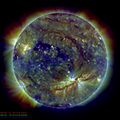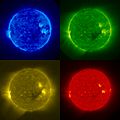Corona facts for kids

The corona is the Sun's outer atmosphere. It's a glowing layer of gas that stretches millions of kilometres into space. You can see it best during a total solar eclipse. It looks like a bright halo around the Sun. Scientists can also study it using a special tool called a coronagraph.
One amazing thing about the corona is how hot it is. The Sun's visible surface, called the photosphere, is about 6,000°C. But the corona is much, much hotter, over one million °C! Even though it's super hot, the corona is not very dense. This means it has fewer particles than the Sun's surface. Because it's so thin, it doesn't give off much light. The corona sits above the chromosphere, which is another layer of the Sun's atmosphere.
Scientists are still trying to figure out exactly how the corona gets so hot. One idea is that the Sun's powerful magnetic field helps heat it up. The outer parts of the corona are always flowing away from the Sun. This flow of particles is called the solar wind.
When the Sun is quiet, the corona mostly stays around its middle, or Equator. There are "coronal holes" over the Sun's poles. But when the Sun is very active, the corona spreads out more. It becomes brightest in areas where there are sunspots.
Sometimes, huge bursts of energy from the Sun, called solar flares or solar prominences, can cause "coronal transients." These are giant loops of material from the corona that shoot out from the Sun. They can travel at over a million kilometres per hour! These events are also known as Coronal Mass Ejections (CMEs).
It's not just our Sun that has a corona. Other stars also have them. Scientists can find these stellar coronae using X-ray telescopes. Some young stars have coronae that are even brighter than the Sun's.
The corona's extreme heat makes its light look unusual. For a while, scientists thought it might be made of a new substance called "coronium." But later, they found out that these unusual features come from known elements. These elements are just super-heated and have lost many of their electrons.
Why is the Corona So Hot?
Scientists have a big question called the coronal heating problem. It's about why the Sun's corona is millions of degrees hotter than its surface. This is a puzzle in astronomy and astrophysics.
To heat the corona, a lot of energy is needed. It's like needing 1 kilowatt of power for every square meter of the Sun's surface. This is about 1/40,000 of the light energy that the Sun gives off. Scientists are still working to solve this mystery.
Images for kids
-
An illustration of solar prominences and sunspots.
See also
 In Spanish: Corona para niños
In Spanish: Corona para niños










